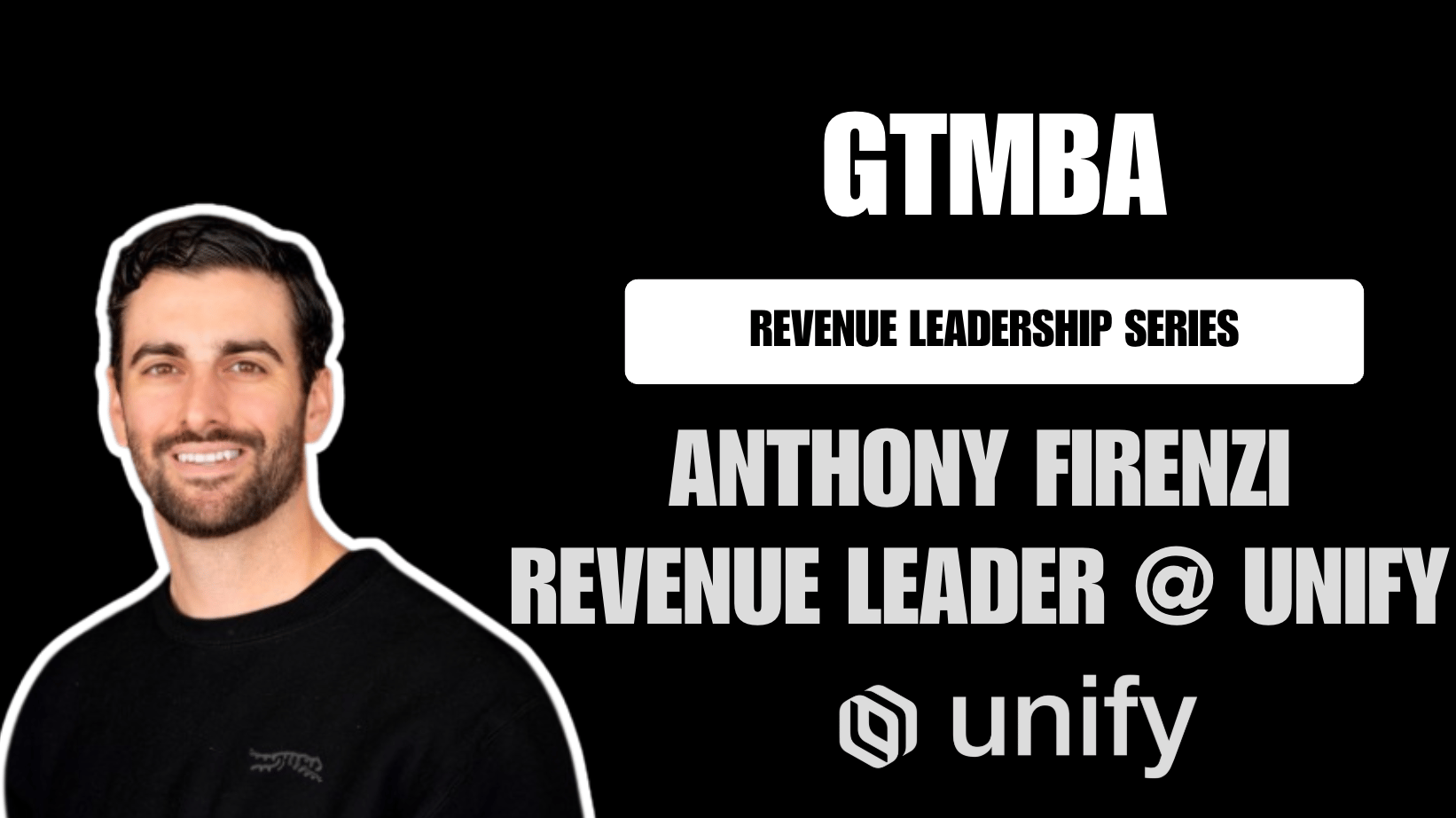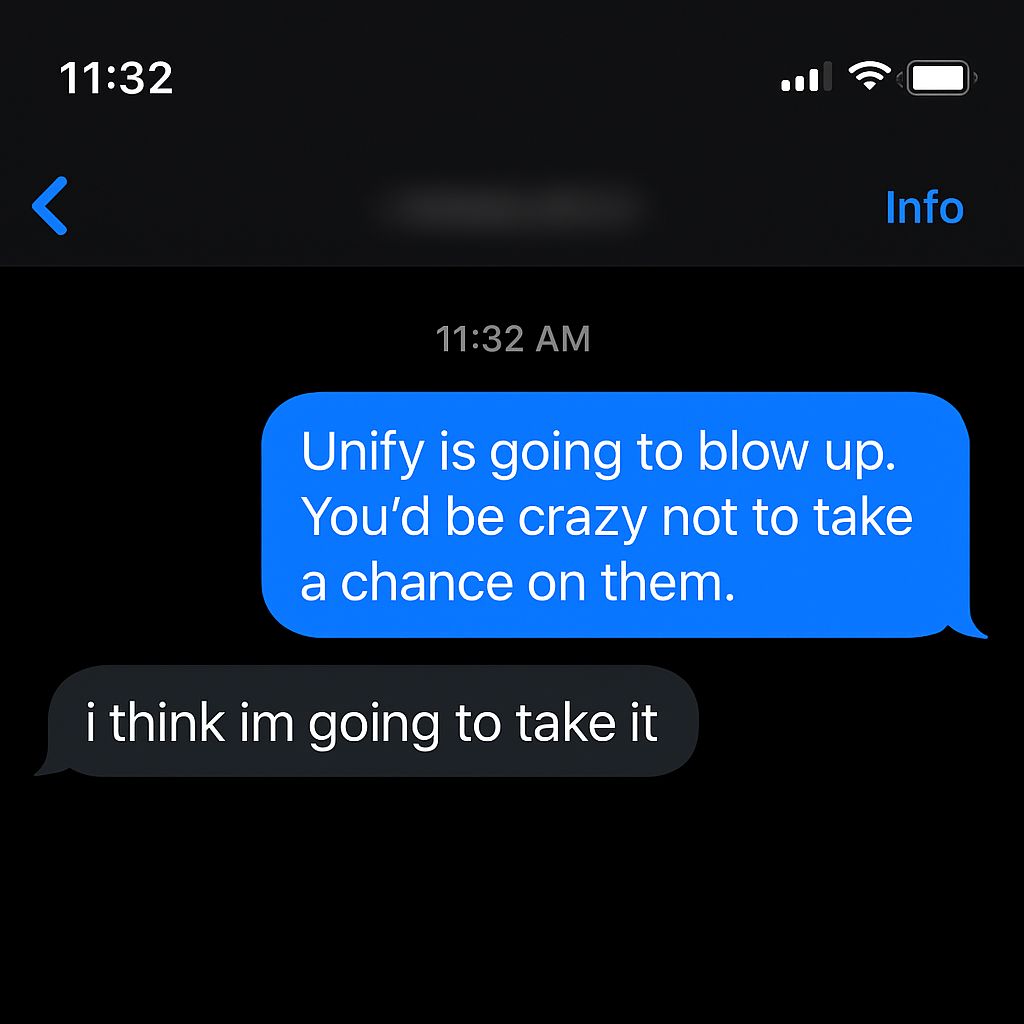- GTMBA
- Posts
- $450k ARR to Series B: The Hypergrowth Leader Playbook
$450k ARR to Series B: The Hypergrowth Leader Playbook
Leadership Spotlight: Anthony Firenzi @ Unify

In GTMBA’s Revenue Leader Series, we give a voice to early & growth stage GTM leaders building their company's Go-to-Market motion. In today’s spotlight, we sat down with Anthony, Revenue Leader @ Unify. Anthony believes deeply in investing in people, because if you take care of your people they will take care of your company.
Julian: You started your career in mortgage lending and switched into tech sales at 26. Out of 30+ companies you interviewed with, how did you land at Lattice and why did this end up being such a pivotal career decision?
Anthony: No one in my family worked corporate jobs so I had to hustle my way in and go based on gut feel. I wish I could say I was calculated, but in part, I got lucky. Lattice was the 30th company I interviewed with and the hiring manager Brian Strubbe was the only person I met that wasn’t reading off a check-the-box hiring script. He wanted to build a real human connection and was hiring based on potential - I took that as a signal of the culture Lattice was building.
I was one of the first 20 employees. We made a big product bet shortly after I joined and the company took off.
This job has been instrumental to my career trajectory because I learned the value to hiring based on potential and built life-long relationships that helped me land the role at Unify.
#2 Julian: You've done multiple founding AE roles, including one at Finley that you openly admit wasn't the right fit. What did you learn from that experience and how did that influence your decision to join Unify?
Anthony: Finley is a great company with amazing people. I was just the wrong person for that role. After early success at Lattice, I thought I could sell anything and blindly followed a mentor without doing the necessary self-reflection going into this role. Product Market Fit isn’t enough - I didn’t understand the buyer (Head of Capital Markets at Financial Institutions) and their pain. At an early stage start-up, it’s your job as the founding AE to live and breathe that pain.
For Unify, I wanted to deeply understand my buyer. Having been a BDR and top performing Outbound AE at Lattice, I understood the Unify buyer well. Next, I watched demos, spoke to customers, backchanneled with people I trusted, and spoke to AEs about their experience. Finally, I joined fractionally and did a test run before joining full time.

Because of the Finley experience, when I interview people, I am very direct and transparent about what the team needs and ask candidates how they plan to set themselves up for success in the role. Finally, I want all Unify AEs to be able to have a personal “why I’m at Unify” elevator pitch they can include in prospect conversations
#3 Julian: You transitioned from Founding AE to Head of Sales at Unify in under a year. Walk us through how you approached the move into a leadership role.
Anthony: One of my mentors, Dini Mehta (former CRO of Lattice), says “do the job before you get the job.” I joined Unify fractionally, helping out with the sales team and running 1:1s / thinking through deal strategy, which gave me a good understanding of the founding team.
When I joined full-time as an AE, we hit crazy product market fit and had a record-setting Q4. It was clear we needed some leadership to scale out GTM, but before officially moving into a leadership capacity, I was owning 1:1s with every AE and vocal on deal coaching, doing the job, while also maintaining a book of business.
When joining an early stage start-up, it’s also important to set expectations with Founders. Before Day 1, I told Austin, our Co-Founder & CEO, that I intended to join, carry the bag, but that he would get the most value out of me if I could bring out the best of a team of AEs.
#4 Julian: I’d like to push back on your prior response. Many leaders are skeptical of hiring the AE who is overly focused on “leadership” positions. How did you strike this balance of personal goals and doing the job you were hired for?
Anthony: When evaluating companies, I made sure to understand, is this a company / founder who is going to make me just march in a line? I perform best with stretch goals. I was clear that the #1 priority in joining Unify was crushing quota, but that I wanted to work towards leadership opportunities in 1-2 years.
If I’m evaluating a company that doesn’t understand my long term motivation, then it’s probably going to be a bad culture fit. I probably missed out on some “great” opportunities, and that’s OK. I optimized for what was important to me and found a Founder who shared my vision.
#5 Julian: Unify's hiring strategy has evolved through three phases: “hungry builders” to “high-slope talent to “proven professionals.” How do you know when it's time to level up your hiring criteria?
Anthony: Any founding role is going to be one of the most difficult jobs you’ve ever done. There’s no playbook and it’s largely chaos.
Hunger Builders (Seed): Skyer, our first AE, is phenomenal at executing in chaos and doing something with nothing. That’s what Unify needed on Day 1. Most top-tier (on paper) GTM talent won’t go to a seed stage start-up, so we needed to find someone to take a bet on.
High Slope Talent (Series A): Once we built a rudimentary playbook, it was time to hire SMB reps, who were early in their career, but thrive with stretch opportunities. We took a bet on talent and work ethic over proven GTM success.
Proven Professionals (Series B): Now that we’ve raised our Series B, have a proven playbook, and consistent growth, we’re focused on hiring proven enterprise AEs who can uplevel our team’s professionalism and help us scale from $XM ARR to $25M+ ARR.
#6 Julian: You've promoted everyone on your sales team within 7 months, including moving a BDR all the way to mid-market AE. What's your philosophy on internal promotion, and how do you identify who's ready for the next level?
Anthony: One incredibly rewarding element of the evolving company stages is seeing people we hired in Phase 1 and Phase 2 who are now in leadership roles. Similar to how I was given the stretch opportunity as a GTM leader, I empower my team to step up before any formal promotion.
For example, we needed another mid-market rep. We needed our first enterprise rep. We needed someone to lead the NBR program. As SDRs and AEs stepped up, prospects and customers were receptive, which gave me signal that these individuals were ready to move into a new official capacity.
#7 Julian: You care deeply about building a culture of collaboration across the Unify GTM org. Talk to us about your recent company offsite in Nashville and how you made that more than just a fun, team-building exercise.
Anthony: We optimized for two things at the offsite - cross-team collaboration and skill development. It was critical for reps to work with people they normally don’t work with (e.g., NBR team working with the enterprise team to drive cross-functional osmosis).
The most impactful thing we did was a pitch competition. We shared a new pitch deck just before the onsite. For the competition, we broke up into groups where teams got to infuse their own energy and unique perspectives into the pitch. It was a huge growth moment for many individuals and created a low ego “we’ll win and lose together” mentality across the team.
#8 Julian: As a GTM tool, Unify is dogfooding Unify. Give us one specific play that's working particularly well for your team.
Anthony: As a sales leader, you’re always worried about where you’re going to find another 15-25% additional pipeline every quarter. For us, this comes from closed-lost opps, re-engaging prospects we’ve already spoken with. But this can be dozens or even hundreds of opportunities.
We use Unify to create an audience of our closed-lost opps and stack in a filter from various UTM parameters. For example, a prospect is researching one of our competitors. We have a paid ad on that competitor’s landing page on Google. That prospect returns to Unify website and we are alerted in real-time that this person came to us from a closed-lost opp. We have an automatic campaign that will reach out to prospect and in some cases, we’ll hand the lead to our BDR team with a flag to call the prospect immediately.
Perplexity uses Unify to run a similar play, which resulted in 7-figures in closed-won revenue.
#9 Julian: The market for GTM Tech is overly crowded. There are too many tools that seem to do the same thing. Why is now the right time to join the Unify GTM team?
Anthony: First and foremost, there’s pressure on every executive team to invest in AI. Intent signals are the easiest and fastest way to create pipeline that converts to revenue because these prospects are showing interest.
One thing that sets Unify apart is our growth trajectory. The space has evolved quickly. From a product perspective, some players have tried to go deep (intent signals), and others have tried to go wide (automations). We strategically went deep on a few key early product features like Plays, Signals and Sequencing that have allowed us to create a platform and become a single solution. One recent product launch that show exemplifies this is our Unify for Sales Reps because we are now allowing sales reps to work directly with their Growth teams to crush their pipeline goals.
#10 Julian: Give us two hot takes: one on the future of GTM and AI, and one about anything else.
Anthony: There are going to be more 7-figure W2 sales reps than ever before at Series A / B start-ups. These are going to be the AEs that lean into learning & development and are proficient in AI.
One Personal Hot Take: We’ll see multiple companies IPO with well under 500 employees in the near future.
For additional resources on Anthony’s journey and approach sales & leadership, check out: 30 Minutes to Presidents Club
Reply